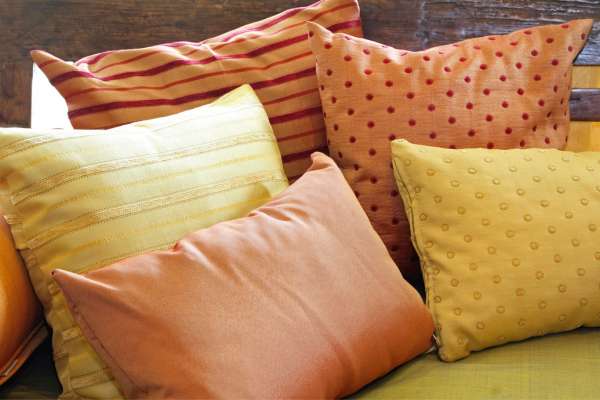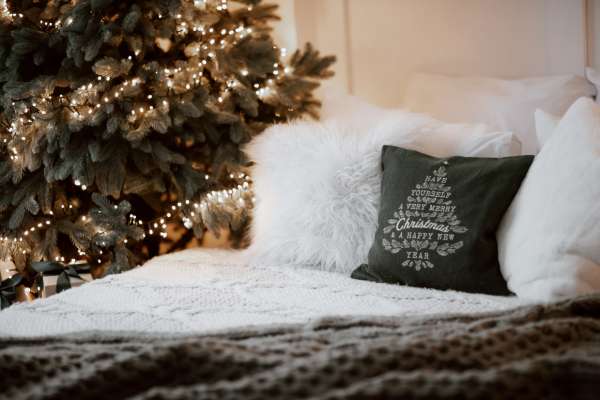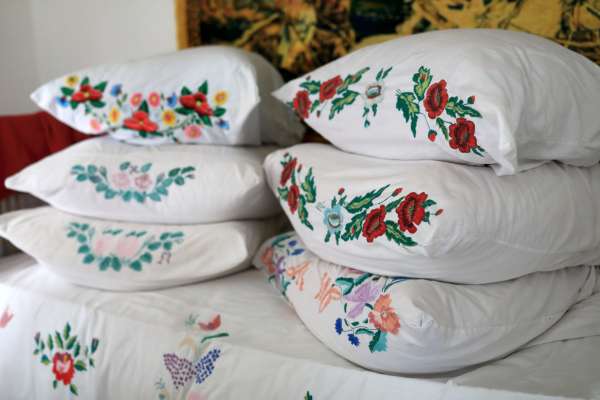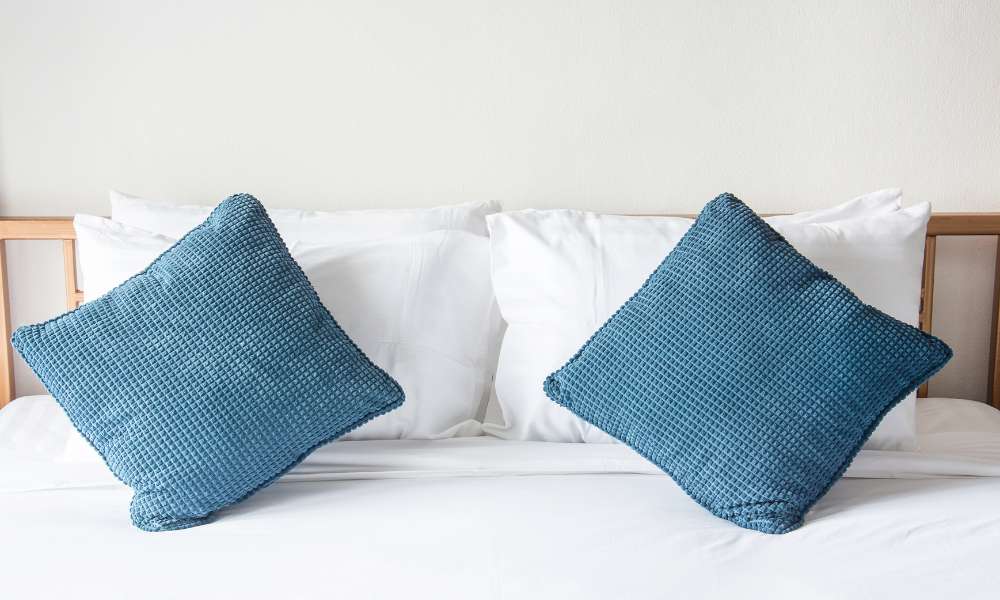Mastering the art of How To Place Pillows on a bed is key to achieving both optimal comfort and aesthetic appeal in any bedroom. This guide delves into the various types of pillows, from standard sleeping pillow to decorative and functional varieties, revealing how their strategic arrangement can transform your sleep experience and bedroom ambiance. Whether you seek ergonomic support or a touch of elegance, understanding pillow placement opens the door to a harmonious and inviting sleeping environment.
Types of Pillows
Standard/Queen/King Pillows:

- Sizes:
- Standard: Typically measures 20 x 26 inches, ideal for twin or double beds.
- Queen: Slightly longer at 20 x 30 inches, fitting queen-sized beds perfectly.
- King: The largest, at 20 x 36 inches, designed for king or California king beds.
- Typical Uses:
- Primarily used for sleeping, these pillows provide head and neck support.
- Can be used as a base layer in decorative bed arrangements.
Decorative Pillows:

- Varieties:
- Throw Pillows: Small, decorative pillow available in various shapes, sizes, and designs to add color and texture.
- Bolsters: Cylindrical pillow that add a distinctive shape and are often used for additional back or arm support.
- Accent Pillows: Specifically designed to complement the room’s decor, often featuring unique fabrics, textures, and patterns.
- Uses:
- Enhance the bed’s visual appeal.
- Provide added comfort when sitting up in bed.
Functional Pillows:

- Types:
- Neck Rolls: A long, cylindrical pillow that offers targeted support to the neck.
- Lumbar Pillows: Specifically designed to support the lower back, ideal for people who read or work in bed.
- Reading Pillows: Large, upright pillow with armrests, providing full back and arm support for sitting up in bed.
- Uses:
- Improve posture and comfort during specific activities like reading or using a laptop.
- Beneficial for individuals with specific support needs, such as those with neck or back issues.
Pillowcase Styles
Selecting the right pillowcases is crucial for both the comfort and aesthetic appeal of your bedding. The style, fabric, and design of pillowcases can significantly influence the overall look and feel of your bedroom. Here’s a guide to understanding different pillowcase styles:
Standard Pillowcases:

- Typically designed to match your bed sheets.
- Commonly used for the pillows you sleep on.
- Offer a simple, functional design without flanges.
Oxford Pillowcases:

- Feature a wide stitched flat hem around the edges, creating a border (flange).
- Provide a more luxurious and traditional look.
- Ideal for both sleeping and decorative purposes.
Housewife Pillowcases:

- Have a sewn edge that fits snugly around the pillow.
- Often preferred for their neat, streamlined appearance.
- Great for a clean and tidy bed setup.
Envelope Pillowcases:

- Contain a tuck-in flap at the open end to securely hold the pillow.
- Offer a neat finish with no loose ends.
- Popular for both their functionality and aesthetic.
Bolster Pillowcases:

- Designed for cylindrical bolster pillows.
- Common in both decorative and therapeutic settings.
- Can add a unique touch to the bed’s arrangement.
Decorative Pillowcases:

- Include a variety of designs like embroidery, lace, and patterns.
- Used to accentuate the decor and add a splash of color or texture.
- Often feature unique closures like ties or buttons for added style.
Specialty Fabrics:

- Silk and satin pillowcases are gentle on hair and skin, reducing friction.
- Cotton, particularly high-thread-count options, offers breathability and comfort.
- Linen provides a rustic, natural look and increases in softness over time.
Basic Pillow Arrangement Techniques
Standard Layout:
- Essentials for Everyday Use:
- Begin with your sleeping pillows, covered with the pillowcases that match your bedsheet. These should be placed flat against the headboard.
- For a double or queen bed, use two pillows side by side. For a king bed, four pillows can be used for full coverage.
- This arrangement focuses on functionality and ease, ideal for daily bed-making.
- Tips for a Neat Appearance:
- Ensure the pillows are fluffed and the cases are smooth for a tidy look.
- The opening of the pillowcases should face the outer edges of the bed to maintain symmetry.
Layering:
- Creating a Stylish Look:
- Start with your standard sleeping pillow at the back.
- Layer with decorative pillow in front, such as shams or accent pillows. Larger pillow should be placed in the back, with smaller ones in the front.
- Incorporate different textures, colors, and sizes for depth and interest.
- Balancing Comfort and Aesthetics:
- Choose decorative pillows that complement the room’s decor but are also comfortable for occasional use.
- This technique is perfect for showcasing personal style and enhancing the room’s ambiance.
Symmetry vs. Asymmetry:
- Symmetrical Arrangements:
- Ideal for a classic, streamlined look.
- Place an equal number of pillows on either side of the bed, mirroring each other in size, shape, and color.
- Works well in traditional or formal bedroom settings.
- Asymmetrical Arrangements:
- Encourages a more modern, relaxed style.
- Pillows of varying sizes and designs can be arranged in a more casual, less structured manner.
- Perfect for expressing creativity and adding a dynamic visual interest to the bed.
The Impact of Pillow Placement on Sleep
The arrangement of pillows on a bed plays a pivotal role in determining the quality of sleep. Proper pillow placement is not merely a matter of bedroom aesthetics; it directly influences comfort, spinal alignment, and ultimately, the quality of rest.
Ergonomically positioned pillows support the natural curvature of the spine, neck, and head, reducing the likelihood of waking up with aches or stiffness. For side sleepers, placing a pillow between the knees can align the hips, mitigating lower back pain. Back sleepers may benefit from a pillow under the knees to maintain natural spine alignment, while stomach sleepers often require a flatter pillow to avoid neck strain.
Moreover, the choice of pillow type – be it firm, soft, memory foam, or feather – further impacts sleep quality, as it caters to individual comfort preferences and specific physical needs. In essence, thoughtful pillow placement, tailored to individual sleeping habits and health considerations, is a critical factor in promoting restorative sleep, contributing to overall well-being and vitality.
Pillows for Different Bed Sizes
Single and Twin Beds: Optimizing Pillow Placement
- Focused Comfort:
- Ideal for one sleeping pillow, often a standard size.
- Additional one or two small decorative pillows can enhance comfort without overcrowding the bed.
- Maximizing Space:
- Use of a single large or two small accent pillow adds a touch of style without taking up too much space.
- Bolster or lumbar pillow can serve as functional decor, offering back support for reading or studying.
Double and Queen Beds: Balancing Functionality and Design
- Symmetrical Arrangement:
- Two to four standard or queen pillows work well, providing ample support for two people.
- Add a layer of two to four decorative pillows to create depth and interest.
- Design Harmony:
- Choose a mix of larger shams and smaller throw pillow to create a balanced, inviting look.
- Consider the room’s decor when selecting pillow fabrics and patterns to ensure cohesion.
King and California King Beds: Strategies for a Luxurious and Comfortable Setup
- Luxurious Comfort:
- Start with three to four king-size pillows for ample coverage and support.
- Layer with decorative shams and accent pillows in varying sizes for a plush, inviting look.
- Elevated Style:
- Incorporate larger Euro shams at the back for height and dimension.
- Mix textures and patterns in the decorative pillow to add sophistication and elegance.
- Consider functional pillows like bolsters or neck rolls for added comfort during lounging or reading.
Choosing the Right Pillows
Choosing the right pillows is a crucial aspect of crafting a comfortable and aesthetically pleasing bedroom. The material and filling of the pillow greatly affect comfort and support; options range from the plush softness of down and feather to the firm, contouring support of memory foam and hypoallergenic synthetic fills.
Pillowcases and shams not only protect the pillow but also contribute to the bedroom’s decor, with choices varying from luxurious silk to cozy cotton. Additionally, the color and pattern of pillows should harmonize with the overall bedroom scheme, adding a cohesive touch to the decor. This thoughtful selection ensures both a restful sleep and a beautifully styled bed.
Budget-Friendly Pillow Ideas
Enhancing your bed with a pillow doesn’t have to strain your budget. Affordable options like mixing and matching pillow covers can refresh your existing pillow and transform the look of your bedroom. Opting for synthetic fills over luxury down can also significantly reduce costs while still providing comfort. Consider DIY pillowcases from unique fabrics or repurposing gently used items for an eco-friendly and budget-conscious approach. Seasonal sales and discount stores are great places to find high-quality pillows at a lower price. These budget-friendly ideas allow for creative expression and comfort, making it easy to elevate your bed’s aesthetic without overspending.
Maintenance and Care
Proper maintenance and care are essential to keep your pillow fresh, supportive, and long-lasting. Regular cleaning, according to the manufacturer’s instructions, helps maintain hygiene and fluffiness. Pillows should be replaced every 1-2 years, or when they lose their shape and support. For storage, keep extra pillows in a dry, ventilated space, preferably in breathable cotton bags to protect them from dust and moisture. Vacuum-sealed bags can save space but may compress and change the pillow’s structure. Rotating pillows periodically ensures even wear and prolongs their life, ensuring your bed remains a haven of comfort and support.
Read more : How To Arrange Pillows On Bed Without Headboard
Conclusion
Mastering the art of pillow placement and selection is key to both comfort and bedroom aesthetics. From choosing the right types and arrangements for various bed sizes to selecting the ideal materials and coordinating colors, pillows significantly enhance your sleeping experience. Remember to maintain your pillow well through regular cleaning and timely replacement. While guidelines are helpful, the most important aspect is to experiment and embrace your personal style. Let your bedroom be a reflection of your unique tastes, creating a space that is not only visually pleasing but also a haven of rest and relaxation.
